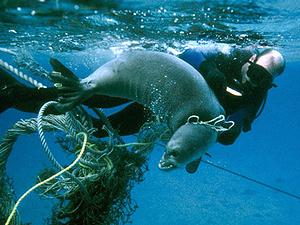Ilio-holo-ikauaua, the Hawaiian phrase that describes the Hawaiian monk seal as the dog that runs in the sea. Currently, only 1200 seals remain near the Northwestern Hawaiian Islands and the Main Hawaiian Islands. Valiant efforts have been made over the past 20 years to preserve and restore the population, but not enough progress has been made to remove the Hawaiian monk seal from the endangered species list. The Hawaiian monk seal is currently the most endangered endemic marine mammal in the United States, as well as one of the most endangered marine mammals in the world. Their population has declined over 60% in the last 50 years. If the current recovery plan is not successful, we could lose them completely within the next 40 years.
Main factors in the endangerment of Hawaiian monk seals are:
- entanglement in fishing nets
- predation by sharks
- potential disease due to low population and limited geographic range
- disturbance from human interaction and habitat interference
- food limitation causing starvation and low survival rates in young
In order to effectively recover their population, full cooperation from federal, state, and private stakeholders is necessary. The goal for the recovery plan is to provide sufficient nutrients for young female seals, who are currently suffering the most. By preserving the young females, there is potential to recover the species. Without these females, the species would not make it.
Current Species Status: The Hawaiian monk seal has been on the endangered species list since 1976. They have a recovery priority number one due to the high magnitude of threats and high potential for recovery. There is big concern with their genetic diversity because of their limited population.
 Habitat Requirements: Monk seals need land for pupping, nursing, molting, and resting. Sandy beaches are their primary source for these needs, but usually they use whatever is available. They spend 2/3 of their time in marine habitat. They search for food in a broad range of depths but their food source is limited, causing problems for survival, especially in females and pups.
Habitat Requirements: Monk seals need land for pupping, nursing, molting, and resting. Sandy beaches are their primary source for these needs, but usually they use whatever is available. They spend 2/3 of their time in marine habitat. They search for food in a broad range of depths but their food source is limited, causing problems for survival, especially in females and pups.Recovery Goal and Strategy: The goal for the monk seal is to restore their population so we can get them off of the endangered species list. The best way to do this would be to maintain current population, particularly of the young females; reduce susceptibility to disease and predation, intervene when necessary, and protect population from interaction with fisheries and potential human hazards. If female survival rates can be kept up, along with population sizes past a certain set point, the Hawaiian monk seal could be reevaluated for the classification of a threatened species.
Sources:
http://ecos.fws.gov/docs/recovery_plan/hawaiianmonkseal.pdf
http://www.marine-conservation.org/what-we-do/program-areas/mpas/pacific-islands-conservation/hawaiian-monk-seals/
http://www.monachus-guardian.org/factfiles/hawai01.htm
http://kahea.org/issues/ocean-protection/hawaiian-monk-seals



No comments:
Post a Comment